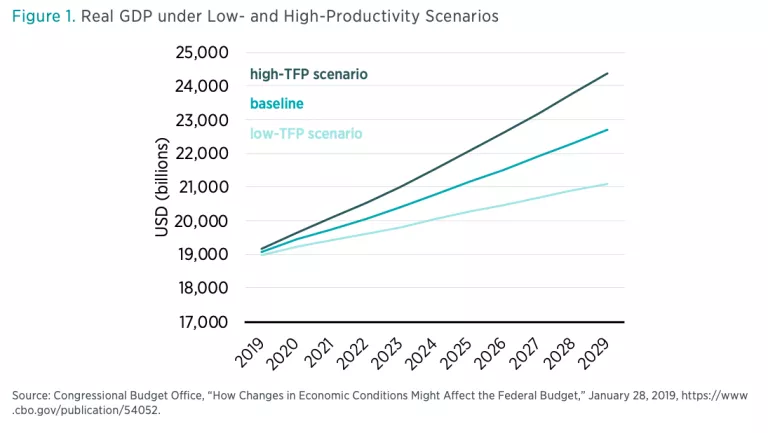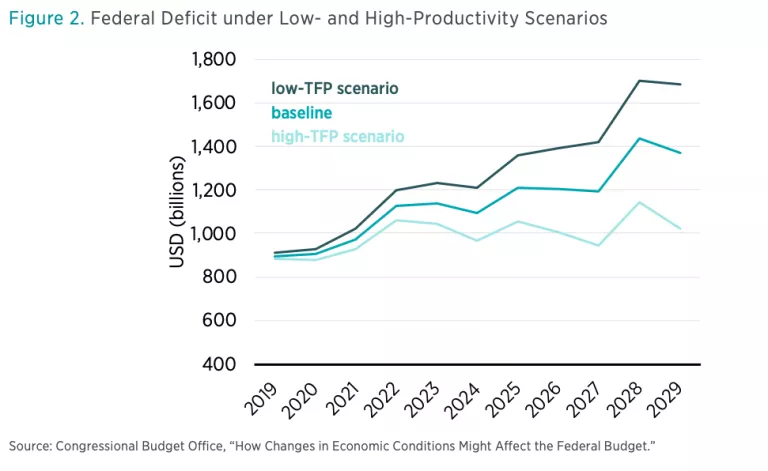- | Government Spending Government Spending
- | Policy Briefs Policy Briefs
- |
Cutting Red Tape to Cut the Deficit
An Innovative Approach to Balancing the Budget
To rein in fiscal deficits, policymakers traditionally raise taxes or cut public spending. However, many economists worry that those policies can slow down the economy. By contrast, faster economic growth—without changing taxes or spending—reduces the deficit on two fronts, by raising revenue and by reducing demand for safety-net public spending. In this policy brief, we argue that boosting economic activity by reducing the regulatory burden works indirectly as a deficit-reducing policy.
This brief offers a pragmatic roadmap for reducing the budget deficit through cutting red tape. First, we highlight how boosting productivity performance is critical to achieving faster economic growth. Second, we discuss how economic growth impacts the deficit. We conclude by offering evidence that regulation tends to worsen productivity, especially in product and labor markets, and that regulatory reform that results in productivity-enhancing growth could be a powerful way to improve the dire budget outlook for the United States.
Total Factor Productivity
Total Factor Productivity (TFP) is a measure of how much total production (output) is not explained by observed factors of production (inputs). The Bureau of Labor Statistics (BLS) takes into consideration the following inputs into the production process: capital (K), labor (L), energy (E), materials (M), and purchased services (S). Under a standard growth accounting framework, any changes in output (Y) that cannot be attributed to changes in the measured factors of production are the result of changes in TFP, as expressed in equation 1.

Economists have long stressed the importance of TFP in explaining economic growth. For example, Moses Abromovitz, Robert Solow, and John Kendrick have documented the importance of the TFP “residual” in accounting for the bulk of measured growth since the early 20th century. Recent research on the components of economic growth corroborates these claims, with some studies finding that as much as 80 percent of growth in the United States since 1948 is the result of broadly defined changes in TFP. While TFP includes the unmeasurable inputs or unknown components of economic growth, it is widely believed that some of these difficult-to-measure inputs are innovations related to new technologies, ideas, and production processes.
Productivity-driven growth reduces government deficits through several channels: First, strong growth in TFP increases GDP and, by extension, government revenues. This is partly the result of real bracket creep. Higher real and nominal income pushes some taxpayers into higher tax brackets, so tax revenue rises. Second, the use of programs such as unemployment insurance and food stamps tends to decrease during periods of economic expansion. Such programs are known as automatic stabilizers because they increase public spending during economic downturns. In addition to shrinking government deficits, increases in TFP drive living standards higher, in part because worker compensation and payments to capital tend to track productivity changes, and in part because increases in TFP occur alongside technological innovation, which has far-reaching beneficial consequences for human well-being.
TFP and Growth
To project how changes in the economy can affect economic growth as well as the federal government’s fiscal position, the Congressional Budget Office (CBO) has developed a new interactive data tool that allows users to see how changes in certain economic conditions affect the federal budget. Figure 1 illustrates the TFP-GDP relationship. Since TFP is a one of the strongest predictors of economic growth, it follows that low TFP growth would constitute a drag on GDP growth and high TFP growth would correspond with robust economic growth.

The CBO baseline GDP estimate for 2029 is $22.7 trillion (2012 dollars), which corresponds with real GDP per capita of around $64,000. We estimate the growth effects of changes in TFP growth for the coming decade using the minimum and maximum values allowed by CBO’s interactive tool to simulate TFP growth. The low-productivity-growth scenario assumes a TFP growth rate of 0.4 in 2019, 0.5 in 2020, and 0.6 thereafter up to 2029, while the high-productivity-growth scenario assumes a TFP growth rate of 1.4 percent in 2019, 1.5 percent in 2020, and 1.6 percent thereafter. The CBO TFP baseline is 0.9 percent for 2019, 1.0 for 2020, and 1.1 thereafter. The scenario of low productivity growth assumes levels similar to those experienced in the United States during the period 1975–1990, and the high-productivity-growth scenario assumes levels similar to some estimates of the levels experienced during the period 1996–2004.
Under a scenario of low TFP growth, with all economic variables fixed at CBO’s baseline projection rates, real GDP would be about $1.6 trillion below baseline projections by 2029. Under CBO’s high-TFP-growth scenario, by contrast, real GDP in 2029 would be almost $1.7 trillion higher than the baseline projection. The high-growth scenario equates to a real GDP per capita around $69,000 in 2029, a difference of approximately $5,000 per capita compared to the baseline and over $9,000 compared to the low-TFP-growth scenario. In the long run, this represents a significant boost in living standards for Americans.
The impact of TFP growth on real GDP is significant. These relatively small changes in growth scenarios constitute a difference of around $3.3 trillion in the size of the US economy by 2029—this is larger than the entire economies of France or the United Kingdom today.
TFP and the Budget
We also estimate the budgetary effects of changes in TFP growth for the coming decade using the minimum and maximum values allowed by CBO’s interactive tool. Figure 2 illustrates the changes in the federal deficit under both a high- and a low-TFP-growth scenario.
With all other interactive variables fixed at CBO’s baseline projections, the low-TFP-growth scenario would add $1.49 trillion more to the national debt over the next decade relative to the baseline scenario. Under a high-TFP-growth scenario, by contrast, the fiscal deficit would be reduced over the next decade by almost $1.61 trillion relative to CBO’s baseline scenario. In other words, the cumulative fiscal impact of low vs. high TFP growth in the coming decade equates to a $3.1 trillion change in the national debt.

Improve Productivity Performance through Regulatory Reform
There are both direct and indirect ways by which regulation can impact the government’s finances. First, red tape often results in more government spending than is necessary and less tax revenue. Ineffective and wasteful regulations require government administrators to write and enforce them. This costs money. Furthermore, compliance costs eat away at the profits of regulated businesses and by extension the earnings of households. This reduces tax revenue. Cutting regulations, therefore, should directly reduce government overhead and increase firm profits and household incomes, thereby raising government revenue.
In addition to these direct channels by which regulations increase government spending and lower tax collections, empirical research finds a connection between regulations and productivity, which provides an indirect mechanism by which regulations impact government finances. For example, previous research from the Mercatus Center at George Mason University has found that regulations, particularly in product and labor markets, harm firms’ productivity. This is consistent with a large body of academic research that has found that mandated employment protections reduce TFP growth, that product market regulations reduce productivity growth, and further, that product market and labor market regulations interact in ways that are harmful to productivity. Economist Antony Davies, using data from the BLS and the Mercatus Center’s RegData tool, has similarly found that industries with lower levels of federal regulation outperform more heavily regulated industries in a variety of measures of productivity.
A complete literature review of the evidence that regulation impacts productivity is beyond the scope of this brief. Nonetheless, the evidence presented here suggests that regulations negatively impact productivity and, by extension, growth. These effects seem to be more pronounced in countries farther from the technological frontier, suggesting that regulations have more detrimental effects in the developing world than in the developed world, and they have more harmful effects in industries that haven’t caught up to the latest technology. For instance, countries with lower entry barriers and less state control have a faster process of catching up to best-practice technologies, especially in manufacturing. This suggests that within developed countries, rural areas, which tend to be less technologically developed than urban areas, may be disproportionately impacted by regulation.
Concluding Remarks and Recommendations for Reform
Several regulatory reforms could begin to improve the fiscal position of the United States: First, regulations have effects on the government’s budget directly, and legislators and regulators should make it a priority to limit the fiscal impacts of regulations. To start, these impacts should be tracked and scored by an entity like CBO. Once they are measured, it will be easier to rein in public expenditures resulting from regulatory programs.
Second, placing limits on the amount of regulation, through regulatory caps or by setting explicit reduction targets for the overall level of regulation, could reduce regulatory burdens and stimulate productivity growth. In general, the magnitude of reductions will have to be significant in order for the impact to be discernible at a macroeconomic level.
Finally, mandating sunset provisions for all new regulations could increase the likelihood that outdated regulations will be allowed to expire rather than exist in perpetuity. Florida, for example, is a state where the executive recently took the step of mandating that sunset provisions be built into new regulations. The US president could do something similar through an executive order or a presidential memorandum.
Each or all of these reforms could prove powerful, and the time to act is sooner rather than later. In recent years, the fiscal outlook for the United States has worsened considerably. Part of this deterioration owes to taxes being lowered and spending increasing. But part of the problem emanates from a slowing of economic growth relative to historical norms. While policymakers in Washington tend to focus on raising taxes or cutting spending to reduce the deficit, they should also be looking at policies that increase growth through channels other than fiscal policy. Regulatory reform is one such option.

